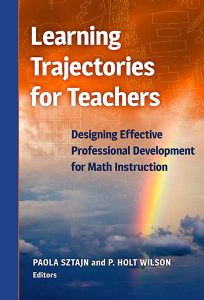By Paola Sztajn and P. Holt Wilson
 “I have seen my students do that, and I wondered what it meant or how to move forward…”
“I have seen my students do that, and I wondered what it meant or how to move forward…”
Experienced teachers who participate in our mathematics professional development often recognize their former students in the information we present to them about mathematics learning. What tends to be new to them is to learn that particular ways in which students approach a problem or concept say a lot about where students are in their learning. More importantly, understanding their students’ strategies also helps teachers think about how to encourage learning and what they need to do next in their mathematics lessons. In these professional development settings, teachers are learning about mathematics learning trajectories.
Researchers interested in mathematics learning have honed in on the concept of learning trajectories. They have worked to develop these trajectories for different mathematical concepts, providing empirically tested maps for how learning can proceed within a particular topic. These trajectories have been used to create standards, curricula, and assessments. But how do we help teachers make sense of them? This question has led several groups to design professional development on learning trajectories. Through these professional development programs, we have come to learn what teachers can do with learning trajectories and also how to best present these trajectories to teachers.
Several studies show that teachers who learn about learning trajectories can select appropriate tasks for their students, sequence mathematics discussions, and improve their lesson design. Teachers come to understand their students’ progress toward fully understanding a particular concept, realizing that students do not immediately go from “not knowing” to “knowing.” Teachers can then recognize and value students as knowers of mathematics, while also asking students the types of questions needed to further knowledge. When used properly, trajectories can address a climate of low expectations as teachers come to better understand the learners in their own classrooms.
Given the potential of these trajectories for teachers, it is fundamental that we think about how to best design professional development sessions. Often, accounts of what happens in particular professional development programs are vague, without describing the moment-to-moment experiences of teachers. Sharing these experiences and what the designers of these professional development sessions learned as they implemented their programs can help us offer more effective professional development. The experiences of professional development designers and providers, however, are seldom shared openly.
Across the nation, four groups have been working on professional development programs on learning trajectories for a quite a few years, designing, refining, and improving their approaches. It’s vital to collect their experiences and insights and examine commonalities across the work of these groups. The successes and struggles across the programs are important for the professional development design community, particularly as requests for professional development on learning trajectories continue to grow.
Take for example, the ways in which learning trajectories are represented. What are important ideas to think about when making these representations useful to teachers? Across the four professional development projects, the teams focused on representations as they learned it was critical to show these trajectories in ways that make sense to teachers. Representations of learning trajectories for teachers need to take into account teachers’ use of trajectories, which is different from the use and needs of curriculum or assessment developers.
It is not uncommon to think that it’s possible to take a tool that is useful to one group and present it to another group in the same format—but this is definitely not the case for learning trajectories. Teachers need trajectories represented in ways that offer information they can easily access and use in the moment, in the classroom, with their students. Knowing how to best represent trajectories for teachers in professional development programs is, therefore, key.
Research on learning has come a long way. Now it’s time to deepen our understanding of how to present this research to teachers. For us to offer better professional development on learning trajectories, it’s insufficient to learn about the effectiveness of different professional development programs that deal with this topic. We also need to share the designers’ experiences, how they worked to improve their programs over the years, and what they learned about designing effective professional development for mathematics instruction.
Paola Sztajn, associate dean for research and innovation in the College of Education at North Carolina State University, and P. Holt Wilson, associate professor of mathematics education at the University of North Carolina Greensboro, are the editors of Learning Trajectories for Teachers: Designing Effective Professional Development for Math Instruction.
